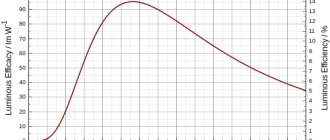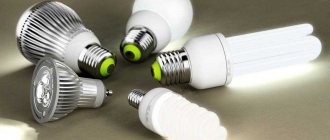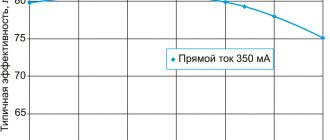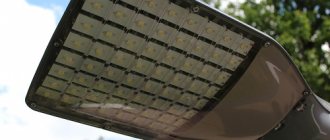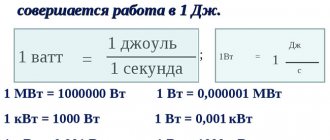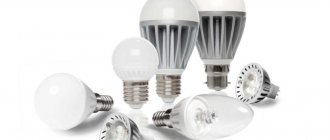There are certain requirements for such lamps that provide street and industrial lighting, illumination of transport routes and structures - a high level of color transmission and contrast of illuminated objects. These requirements are based on the safety conditions when performing work in these areas.
Currently, many organizations are switching in outdoor lighting from the use of gas-discharge lamps to the use of LED analogues. To correctly understand when and where it is appropriate to replace DRLs with LED lamps, you need to consider their characteristics.
Advantages and disadvantages
DLR is a high-pressure mercury arc fluorescent lamp, to which a special type of phosphor is added. Available in power ratings from eighty to one thousand watts. It has a color temperature of 3800 K. Efficiency is estimated at 40 lumens per watt. Works for 10 thousand hours. Has low color rendering.
DRL 250
Widely used for general street lighting, industrial workshops and any uncrowded places. That is, its main use is where color rendering is low and energy saving is high. The main advantage of such lamps is their high efficiency. Among the disadvantages, we can note the fact that ozone is released very intensively, ignition when turned on takes 7 minutes, re-ignition is possible after twenty minutes. In addition, in this lamp it is necessary to turn on the ballast choke, and the concentration of mercury vapor is sufficient to poison a person if the bulb is damaged.
The high pressure sodium tube arc lamp is an economical luminaire that is used for outdoor lighting. It is found on the street, highway, tunnel, train station, airport and industrial area.
The advantage lies in its efficiency, high luminous efficiency (efficiency is 30%) and a long service life - from 12 to 25,000 hours. One of the disadvantages is the rather long ignition time.
Note! In addition, such a lamp does not work well in bad weather conditions.
High efficiency of light flux from DRL lamps
Safety regulations
When using a lamp, you must follow some safety rules:
- Before installing the light bulb, you need to carefully unpack it and make sure there are no mechanical damages;
- It is prohibited to screw in or operate a faulty lamp; you also cannot use an open lamp in an open place where it is not protected from wind or precipitation;
The light bulb must be intact.
After installation, it is necessary to carry out a test by turning on the lamp for 10-15 minutes. After that it can be used
It is important to remember that DRV lamps take several minutes to light up;
Important! If the network voltage is higher than 220 V, the lamps will fail faster and their service life will end earlier
- Any installation of the lamp must be carried out only with the electricity turned off;
- If the light bulb becomes dirty, wipe it with a dry soft cloth. Solvents or aggressive cleaning agents must not be used;
- The lamp can be placed in any position - both horizontally and vertically;
- Light bulbs should be stored in packaging, not dropped or broken, they should not be given to children or allowed to play with;
- It is necessary to dispose of lamps by handing them over to a collection point for mercury lamps.
Due to mercury vapor, disposal must be carried out at special points
If the light bulb does break, you must:
- Ventilate the room for at least 30 minutes, after leaving it;
- Wear disposable gloves and sweep all large parts into a bag using paper or cardboard;
- Use a wet sponge or tape to collect small pieces. Mercury must be collected moving from the edges to the center;
- At the very end, clean using chlorine.
It is necessary to clean up the mercury spill site with chlorine
DRV and DRL light bulbs are often used to illuminate streets, warehouses, workshops and construction sites. They are easy to install and use, easy to install and change, and provide good quality light.
However, both lamps are classified as hazard class 1 due to their mercury content and must be used with caution
Characteristics
The power of DRL lamps is on average 700 watts, the rated current is 12 amperes, the voltage is 140 watts, and the light output is 40,600 lumens. Base type E27 and E40, maximum diameter 152 mm. The average service life is 4000 hours.
As for the technical characteristics of DNAT, in addition to the topic, replacing drl with dnat, it is worth pointing out that the service life with operating temperature is 25,000 hours and 40 degrees, respectively, the base thread type is E27, power consumption is 1000 watts, voltage is 120 volts, light flux - 130 thousand lumens, light output - 130 lumens per watt, wavelength - 640 newtons per meter, and light flux pulsation 70%.
You may be interested in this Features of the E27 base
Specifications and comparison
Stage 4: Calculation of projected costs for electric lighting after replacement.
As we have already found out earlier, the operating time of electric lighting per year will be 4380 hours.
Accordingly, over the course of a year, the modernized street electric lighting of our gardening partnership will consume:
60 lamps * 0.110 kW * 4380 hours = 28908 kW/hours of electricity.
Let's multiply the amount of electricity received by its cost and get the cost per year for electricity after replacement:
28908 kW/h * 3.50 rub. = 101178 rubles.
The declared service life of the LED modules used in Prom-S lamps is 100,000 hours, which, with an operating time of 4380 hours per year, promises almost 23 years of trouble-free operation!
The device of light bulbs
The structure of both light sources today is no secret to those who study the topic of replacing DRL 250 lamps with LED ones. They differ from each other only in that one of them works thanks to mercury, and the other thanks to sodium. The operating principle and design features are the same. Both lamps receive current, where it is heated and converted into thermal and light energy, which spreads along an arc and is supported by special capacitor units.
Design features of lamps
DNAT
The DNAT consists of a discharge tube, electrodes, a ceramic plug, a niobium and barium rod, and a screw base. The main components are an inductive choke, an isu and a phase-compensating condensate. The choke limits the arc current. The IZU increases the voltage in the arc. The capacitor reduces the load on the electrical network.
Note! This is an additional and optional component.
What does a HPS lamp look like?
DLR
DRL is a lamp that consists of a base, a resistor, a limiting voltage, molybdenum foil, an electrode or an igniter. It also includes a frame, yttrium vanadate glass flask, lead wire, tungsten electrode, nitrogen filler, mercury arc lamp and compressed quartz junction.
What does a DLR lamp look like?
LED lamps for road lighting.
Road lighting is not an easy task. In this area, modern LED systems are distinguished by good energy savings and a noticeable minimization of costs associated with the maintenance of lighting devices.
LED lamps, which have proven themselves to be reliable, are often used as suitable lamps. They are more durable than traditional light sources. Drivers notice an objective difference between sections of the road illuminated by LED and conventional lights with the same technical indicators: moving objects and static objects are better recognized due to greater contrast.
Replacing street lighting sources with LED lights has become the norm in developed countries, Europe and the USA, where electrical companies have long calculated the high efficiency of LEDs compared to conventional light bulbs. In addition, energy-saving technologies are actively lobbied at the government level, which declares to use energy-efficient technologies everywhere, including when installing street lighting sources.
Road lighting
However, the high cost of LED street lights scares owners of electrical equipment, but the payback period for LED lights is 3-4 years, so high initial costs are subsequently justified by the low level of power consumption of LED street lights. At the same brightness level, LED street lights are approximately 12 times more energy efficient than incandescent lamps and 4 times more energy efficient than fluorescent lamps.
Where are lamps used?
DRL light bulbs are widely used where it is necessary to illuminate large areas. For example, they are ideal for streets, highways, factory floors, playgrounds, and stadiums. Designed for alternating current and voltage of 220 volts. They are not suitable for installation in residential premises as they emit unpleasant and dangerous fumes. In addition, if the flask breaks, severe poisoning is possible.
DNAT lamps are used to illuminate large areas, wide streets, highways, highways, tunnels, sports complexes, airports, railway stations, architectural structures, workshops, warehouses. They are also actively used in plant nurseries and greenhouse complexes.
Note! They differ in that they heat well and in some ways replace the sun for plants.
Use at gas stations as one of the directions
Technical aspects
The most important indicators of a mercury light source with an e40 base are the design of the internal part of the device, the shape of the bulb, and the dimensions of the threaded base. The economic effect of the device may differ in operating conditions. The gas-discharge soffit from the Lisma brand for street lighting, which does not create a flickering effect in the event of voltage surges in the electrical network, does not require a special device for igniting the arc. At a power of 500 W, a luminous flux of 4 - 5 thousand lm is created.
Characteristics:
- Name - DRV lamp;
- Type - mercury;
- Power - 500 V;
- Shape - ellipse;
- Manufacturer - ;
- Purpose - street;
- The flask coating is matte;
- Base - e40.
When marking energy-saving appliances, digital and letter values are used to indicate the power and type of product. It is not difficult to decipher these meanings. Examples:
- DRL 250 - arc mercury phosphor lamp with a power of 250 V;
- DRV 160 is a mercury-tungsten arc lamp with a power of 160 V.
The source of an even luminous flux DRV 500, the characteristics of which are determined by the parameters of the base, can have a mixed type design. The starter circuit may contain a choke. The ballast serves to reduce the voltage on the electrodes by increasing the voltage in the active luminescent device. The device is made in the form of a coil with a wire wound around a ferromagnetic core. To reduce reactive energy in the E40 lamp circuit, it is enough to disconnect the compensating capacitor.
The technical characteristics of the device are adapted for open spaces. The DRV 500 lamp demonstrates excellent results at a voltage of 220 V with a current oscillation frequency of 50 Hz. The devices are designed for continuous operation for 7.5 thousand hours.
Principle of operation
The DRL lamp works very simply. First, a current is applied, which passes through the base and moves to the electrode. The result is a discharge. Ions with free electrons are formed in the flask.
HPS, after directing the current into the lamp, the pulses enter the isu burner, where the aluminum oxide is heated. Then an arc charge is formed. The burner heats up within 10 minutes and the light source glows brightly. Supports his throttle.
You may be interested in Features of illumination measurement
Operating principle of DRL lamps
Design features
What are DRL 250 lamps made of? Their characteristics include the presence of the following components:
- Nickel plated base.
- A resistor that provides voltage limiting.
- Molybdenum foils.
- Framework.
- Glass flask (the luminomorphic coating is actually applied to it).
- Lead wire.
- Tungsten coated main electrode.
- Nitrogen, which acts as a filler for the outer flask.
- Compressed junction of a quartz light source. The quartz burner is the main working element of the lamp.
By the way, the first models of the lamps described had only two electrodes. However, such a device significantly worsened the process of turning on and warming up the lighting point, as a result of which the presence of an additional starting element called a high-voltage pulse-type breakdown of the burner gap was required. This version of the lamp was very quickly recognized as ineffective and was replaced with a four-electrode version equipped with a choke, without which the operation of such a lamp is simply physically impossible - it will simply burn out the moment it is turned on.
Connection diagrams for DRL and DNA lamps
The connection diagram for the HPS lamp, as well as the DRL, can be seen below. Depending on the number of pins, power and other technical characteristics, the schematic location of the main installations will depend.
DLR connection diagram
It is better that there is a capacitor in the circuit. It will suppress interference and reduce inrush current. As a result, the service life will be extended, even if an analogue of drl 250 is used. The main thing is that it has optimal electrical capacity.
DNAT connection diagram
In general, DRLs are mercury discharge lamps, and HPS lamps are sodium lamps. The first operates on a luminescent type of glow, and the second on resonant sodium radiation. They differ in design, operating principle and connection diagram. It is important to note that you can always find an analogue of the drl 250 LED with a socket of 40.
What is a throttle for?
The throttle is responsible for the correct operation of the light source. Often, powerful devices require impressive network voltage levels. This in turn leads to overheating and burnout of the device. The component allows you to avoid such consequences. In this case, it must be connected in series to the electrical circuit.
Thus, the inductor limits the voltage and current during operation.
Figure 1. DRL choke
To limit current drops, a connection is made through a resistance element. It is a ballast of several inductance coils with high resistance, which prevents the lamp from burning out. In the gas environment of the DRL, an electrical breakdown occurs, leading to the appearance of an arc discharge. The ionized gas loses resistance, which causes an increase in current and the release of a significant amount of heat. If the current is not limited by special chokes, the heated gas environment will damage the lamp.
If the DRL is directly connected to the network, then failure in most cases is a matter of time. More often than not, overheating appears instantly. The rate of breakdown is influenced by specific indicators of the electrical circuit, voltage, external factors (air temperature, humidity, etc.). This only applies to conventional mercury lamps, which make up the majority of the market.
The main parameter for the inductor is the rated current. It is on this basis that equipment is selected taking into account the power of the lighting device. You can use the following table.
| Power of used DRL | Rated inductor current |
| 125 W | 1.15 A |
| 250 W | 2.15 A |
| 400 W | 3.25 A |
| 700 W | 5.45 A |
Despite the usefulness of the throttle, it is increasingly becoming a thing of the past. They are being replaced by modern electronic arc stabilization units. With their help, you can fine-tune operating parameters and control workloads. The set values will be maintained even with significant voltage drops in the network.
Figure 2. Chokes of different parameters
Drl lamps: device, characteristics, selection rules
The reactance of the inductor is related to the parameters of the inductor. 1 Henry of inductance passes 1 A of current at a voltage of 1 V. When considering coils, it is worth considering:
- cross-sectional area of the copper conductor;
- number of turns;
- core material;
- cross section of the magnetic circuit.
The coil also has active resistance, which must be taken into account when selecting parts for specific lighting devices. Chokes of certain sizes are suitable for each type of DRL.
